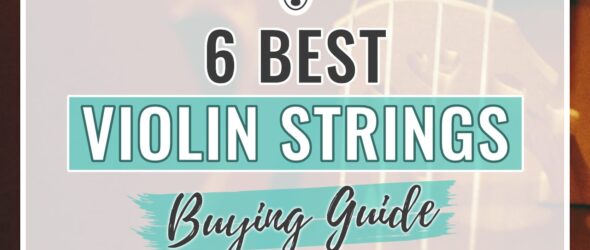The best violin strings organized by your playing level
Have you found that the sound of your violin isn’t as nice as it used to be, despite your technique getting better and better? It may be time to try new violin strings! You can always replace your strings with the same brand as before, but experimenting with different strings can give you a different sound.
Perhaps you’re playing on the low-quality strings that your violin came with. Switching to a decent set of strings will improve your sound, and I bet you’ll enjoy playing the violin even more!
Let’s talk about some of the best options out there so that you can find the right violin strings for your instrument.
My Top 3 Violin String Recommendations
These are the best strings you can buy for each level of playing. Their sound is fantastic, and they all tend to stay in tune nicely.
For more details, read the reviews below!
Understanding the Lingo
When talking about violin strings, there are a few qualities and materials. Let’s clear up these string-related terms!
Core material
Violin strings have an inner core and an outside wrapping. Standard core materials for violin strings are:
- synthetic materials – synthetic strings have a warmer sound
- steel – these strings tend to have a more metallic tone
- gut – the gut strings are the warmest with rich overtones but have a slow response time.
Winding material
The winding material is the outer layer of the string. Popular winding materials include plated steel, aluminum, nickel, silver, and gold.
Note: steel core strings generally don’t have a “winding”; they’re just completely steel.
Gauge
The string gauge tells us how thick the string is. Thick gauge strings require low tension and have a slower response time. Thin gauge strings require higher tension and produce a bright sound. Medium gauge strings are the most popular violin strings because they’re a happy middle and provide a focused tone without much response time.
String Tension
Along with the gauge, some strings will require more tension on the violin than others. Higher tension will result in a brighter sound, and lower tension creates a warmer, slower sound.
End type
Violin strings can have either a ball end or a loop end that goes into the tailpiece.
Today, ball end is the most popular, because our modern tailpieces and fine tuners are made to hold this type of string. The ball end feeds right into the grip attached to the fine tuner, or into the hole of the tailpiece if you do not have fine tuners.
Loop ends are more traditional, and are held by a claw at the end of the tailpiece. You may need this type of string if you have an older instrument with this particular setup.
Response time
The response time is how long it takes the string to speak fully. Thicker strings can take a seemingly long time to produce the sound you’re looking for. Have you ever heard a double bassist play? It takes a second to really get the string going because they’re so long and thick!
Of course, violin strings are much thinner and have higher tension than bass strings, but some brands and types of strings will speak faster than others.
Tuning stability
Temperature and humidity changes are never great for your violin since it’s made of wood, but some types of violin strings handle these changes better than others.
Some violin strings will go completely out of tune when you transport your violin in the winter; others will not. Some strings will go out of tune when you play a concert outdoors, while others don’t.
The tuning stability tells us how well a set of strings stays in tune under environmental changes. Of course, there are other factors in play, like your violin pegs expanding or contracting due to the weather, causing the strings to fall out of tune.
Best Violin Strings by Level
Some violin strings are easier to maneuver than others, making some strings easier to use for beginners, and others better for those who have an intricate knowledge of the violin. These are my favorite strings divided by playing level.
Good Violin Strings for Beginners
The strings below are reliable and achieve a nice sound without putting in too much work. They’re relatively inexpensive, which is super helpful if you’re experimenting with different brands to find what sounds best on your instrument.
1. Pirastro Tonica
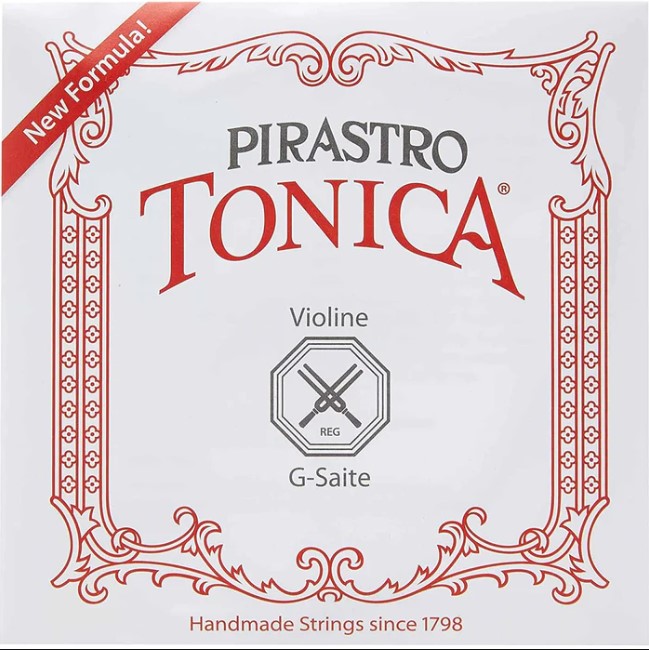
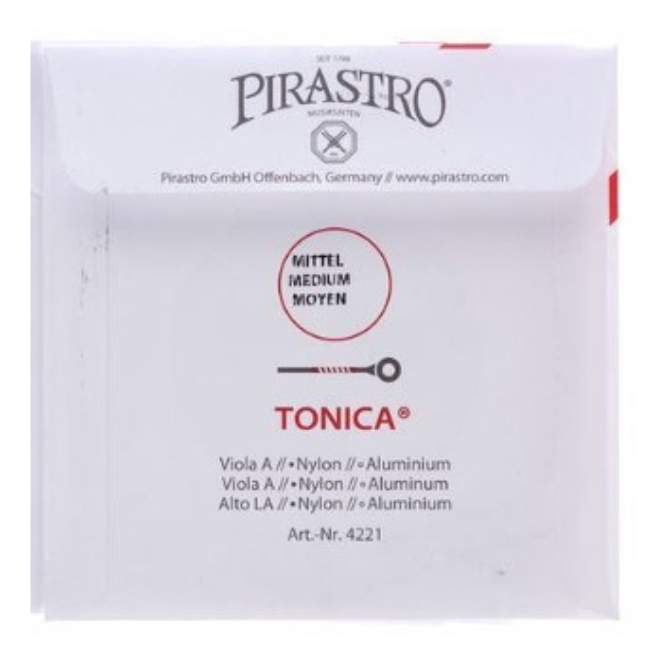
SPECIFICATION
Full set starts at $27
Core material: G, D, and A: synthetic; E: steel
Winding material: G and D: silver; A and E: aluminum
Gauge: medium
REASONS TO BUY
+ Great value for the price
+ Neutral tone lends itself well to most violins
+ Balanced tone between all four strings
+ Sound similar to Dominant violin strings but at a cheaper price
REASONS TO AVOID
– Take a while to break in
– Degrade quickly
– Not as loud as other string sets
I recommend Pirastro Tonica strings to most of my violin students; not just beginners! These strings are reasonably priced, and carry a neutral tone, meaning they’ll sound nice on most violins. Pirastro Tonica set is often compared to the very popular Dominant violin strings, which I’ll talk about later. Pirastro are synthetic core strings, just like Dominant, but are priced a little lower.
Pirastro Tonica is a great string set for beginners because it’s reliable, and sounds good on most instruments!

Pirastro Tonica
Support us for more FREE content No extra costs for you Recommended by Violinists
2. Prelude Violin Strings
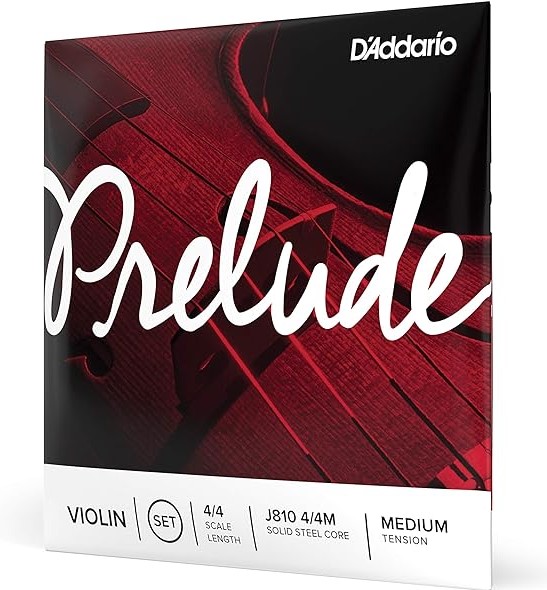
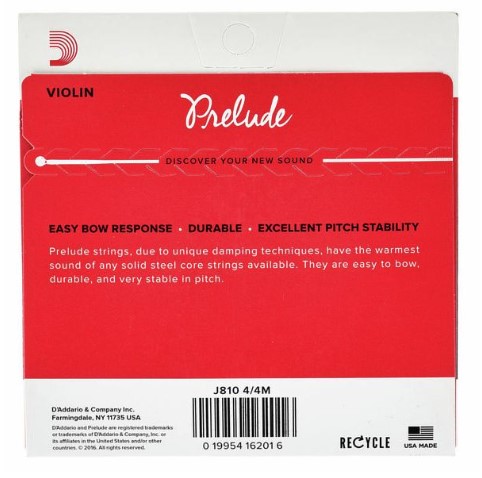
SPECIFICATION
Full set starts at $19.99
Core material: steel
Winding material: G and D: nickel; A: aluminum; E: steel
Gauge: medium
REASONS TO BUY
+ Very cheap
+ Reliably stays in tune through temperature and humidity changes
+ Quick response
REASONS TO AVOID
– Don’t provide a very rich sound
– Nickel on the G and D strings can cause irritation to those who are allergic
Prelude is a very affordable option for beginner violinists. This can be a good brand to try first if you plan to experiment with different strings: it’s a cheap investment!
Quite a few student violins and school instruments come pre-strung with Prelude strings. If you know that your violin came with these strings and you like the way they feel, there’s no shame in repurchasing when your current strings are past their prime!
Preludes are steel core strings. This type of string is thinner than synthetic and gut strings and tends to be a little brighter. They also stay in tune despite environmental changes like temperature and humidity.
Many fiddle and bluegrass players choose steel strings to help project over their jam groups. This can be a great brand to try if you’re interested in that style of music!

Prelude Violin Strings
Support us for more FREE content No extra costs for you Recommended by Violinists
Violin Strings for Intermediate Players
The strings I recommend for intermediate players produce more complex sounds and overtones, which will boost your sound as long as you play with good technique! These are more expensive strings, and they sometimes require more maintenance and nuance to achieve the best sound.
1. Dominant Strings
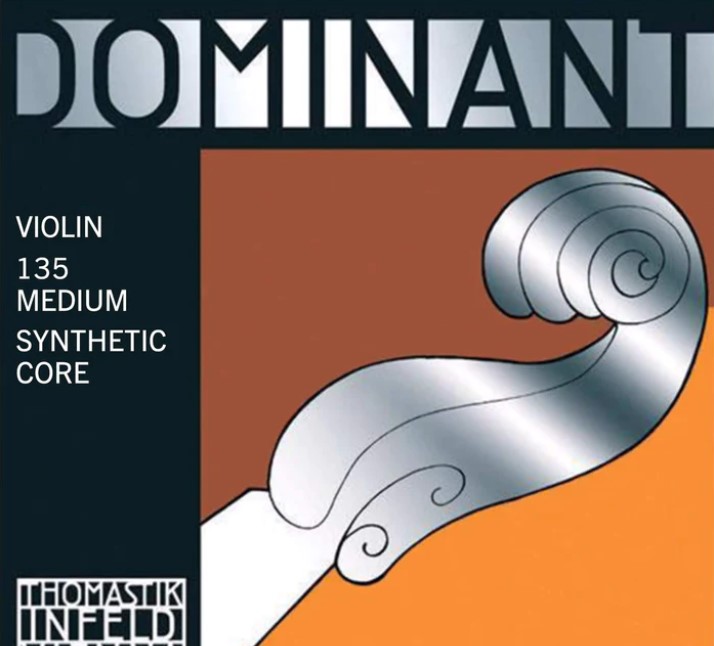
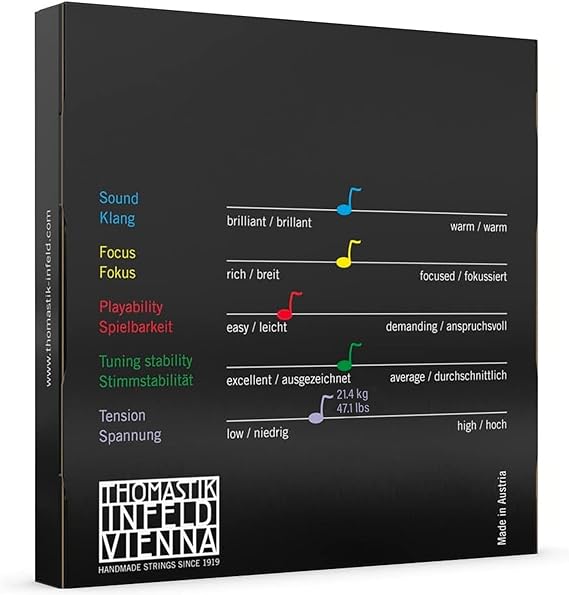
SPECIFICATION
Full set starts at $44
Core material: G, D, and A: synthetic; E: steel
Winding material: G: silver; D and A: aluminum
Gauge: medium
REASONS TO BUY
+ Reliable strings used by many violinists
+ Synthetic core gives a warm sound while staying ethical
+ Stay in tune through changes in temperature and humidity
+ Average string price
+ Last for a long time
REASONS TO AVOID
– Might not sound good on your instrument
– E string can squeal or whistle on some violins
– Only offered in one gauge
A favorite set of strings for many players is Dominant, made by Thomsatik-Infeld. The bottom three strings are synthetic, and the E string has a steel core. This is one of the most popular modern strings, and for good reason! They’re very reliable and sound beautiful for a long time.
Even a few famous violinists use Dominant strings because of their great sound and reliability. They create a beautiful warm tone, and the synthetic core will feel more like playing a gut string than steel strings do.

Dominant Strings
Support us for more FREE content No extra costs for you Recommended by Violinists
2. Helicore Strings
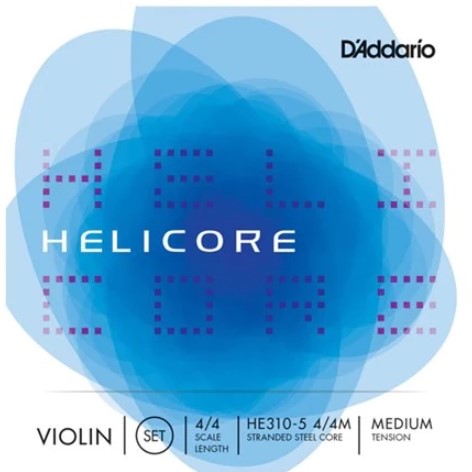
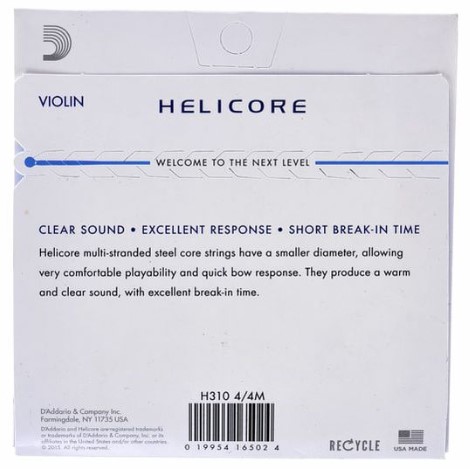
SPECIFICATION
Full set starts at $51
Core material: Steel
Winding material: G: silver; D: titanium; A: aluminum; E: steel
Gauge: Medium
REASONS TO BUY
+ Good for fiddle playing
+ Can last for a very long time
+ A bit warmer than most steel strings
+ Cheap
REASONS TO AVOID
– Can sound fairly bright on some violins
– The winding can deteriorate before the string sound dies
Helicore violin strings are a smart option for intermediate players who are interested in steel core strings. Steel core tends to work best for fiddle players and others who want a bright enough sound to cut over a larger ensemble. However, Helicore strings tend to provide a darker tone than most other steel strings.
These strings are known to last for a long time and stay solidly in tune. They’re very reliable strings for an intermediate player.

Helicore Strings
Support us for more FREE content No extra costs for you Recommended by Violinists
Violin Strings for Advanced Players
Finally, let’s talk about violin strings that work well for advanced players. These strings are highly regarded by professionals, and will likely sound good on many different violins. In general, these higher-level strings have more winding and gauge options which allow you to curate the desired sound on your instrument.
1. Evah Pirazzi
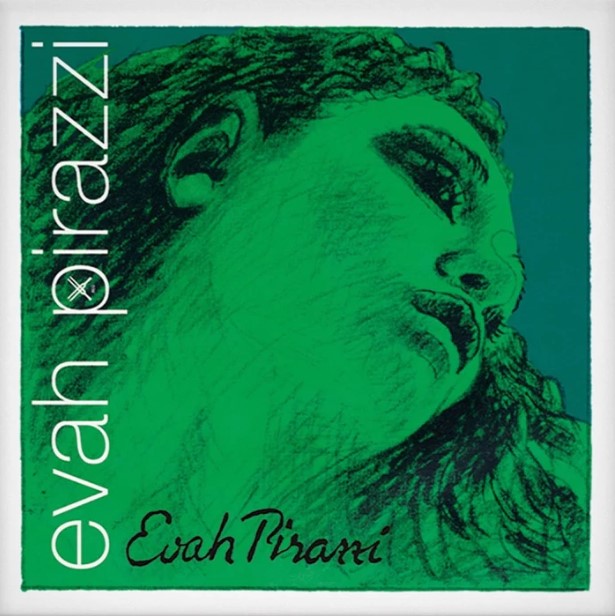
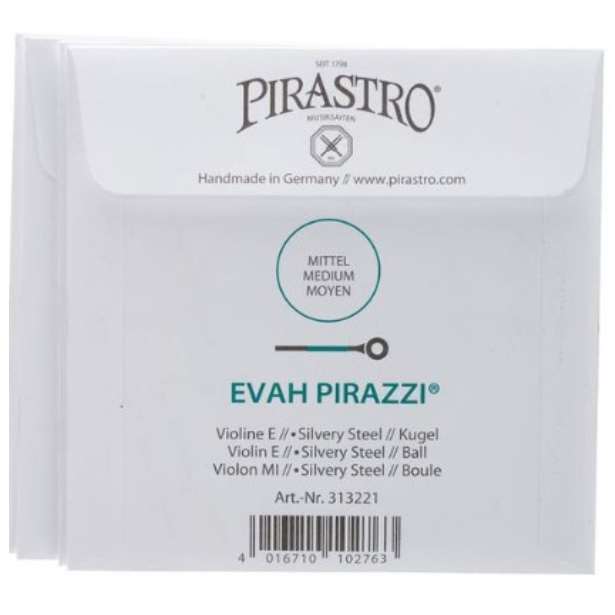
SPECIFICATION
Full set starts at $79
Standard set core material: G, D, and A: synthetic
Standard set winding materials: G and D: silver; A: aluminum; E: steel
Standard set gauge: medium (also available in thick and thin)
REASONS TO BUY
+ Powerful, brilliant sound
+ Direct response
+ Great for solo playing – can cut through an orchestra
REASONS TO AVOID
– They may take a while to break in
– These strings tend to wear out faster than others
– Can sound too bright on some violins
Evah Pirazzi is a very standard choice for professional violinists, especially those who play solo. The synthetic core strings feel and react a bit more like traditional gut core strings, without the added maintenance or guilt. The strings provide a direct, brilliant tone that lends itself perfectly to solo work.
This line of synthetic strings provides a complex sound. Harmonics speak easily, and the strings produce a lot of overtones. Overall, I think Evah Pirazzi provides a great playing experience.
One large negative, however, is that these strings do tend to wear out faster than a lot of other popular strings like Dominants. Since Evah Pirazzi comes at such a high price tag, it can make replacing them quite expensive.

Evah Pirazzi
Support us for more FREE content No extra costs for you Recommended by Violinists
2. Vision Solo

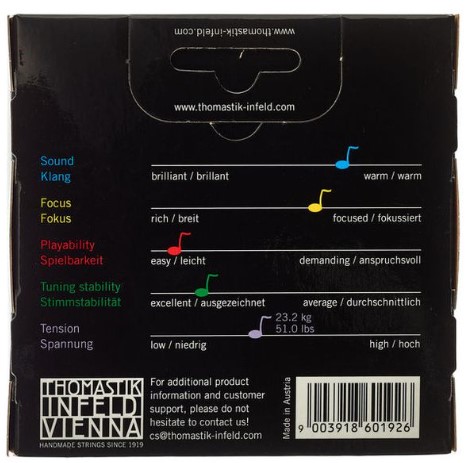
SPECIFICATION
Full set starts at $53
Standard set core material: G, D, and A: synthetic; E: carbon steel
Standard set winding material: G: silver; D and A: aluminum; E: tin plated but they also offer many other windings
Gauge: medium
REASONS TO BUY
+ Quick response time
+ Warmer sound than Evah Pirazzi
+ Break in quickly
+ Very strong tuning stability
REASONS TO AVOID
– They can die (wear out in terms of sound) very suddenly
– Sometimes have a tinny, metallic sound before fully breaking in
All around, Vision Solo is a very reliable string line to go with. These strings are less bright than Evah Pirazzi, meaning they’ll likely sound full and warmer on most violins. These are also synthetic core strings, giving them a round, full sound.
There are quite a few different string sets within the Vision line: Vision, Vision Solo, Vision Titanium Solo, and Vision Titanium Orchestra, all boasting different tones for particular situations. I prefer Vision Solo for their reliability and clean sound.

Vision Solo
Support us for more FREE content No extra costs for you Recommended by Violinists
Mixing and Matching Strings
Ideally, you want to be able to buy just one pack of strings for your whole violin, but instruments that aren’t perfectly adjusted might require different types of strings to create a uniform sound across the instrument. You may also just like different tones for different strings. It’s completely okay to mix and match strings to create your own custom set!
Finding Your Own Complete Set
But how do you choose the right violin strings for your instrument?
If you can remember qualities that you did and didn’t like about previous string sets you’ve tried, you can start there. If you liked the G and D strings from, say, the Dominant strings you tried, and the A and E strings from Vision Solo, you could try those four strings at once and see if you like the blend.
Mixing and matching violin strings is a very personal decision, and every player has their own preference. As you play more and more and strengthen your listening skills, you’ll have a better understanding of your own instrument and of the exact tonal complexity you hope to achieve.
Many websites that sell violin strings have their own string-buying guides and charts that show you the sound qualities of most string sets. If you’re looking for a warm, but direct sound, you can find that intersection on the chart and choose a string set that provides those playing qualities.
It’s very helpful to make notes about all the different strings you try for future reference. After years of playing and experimenting with different brands of strings, it’s easy to forget what each brand of string sounded like unless I specifically wrote it down!
Popular String Combinations
Many violinists don’t like their E strings and search for the “perfect” one. This leads a lot of us to mix and match.
A very popular string setup is using Dominant brand G, D, and A strings with a Pirastro Gold Label E string. These two brands tend to blend nicely together on most violins.
Another popular string combination is Evah Pirazzi G, D, and A string with a Hill E string.
Buying strings in sets is cheaper than buying each one separately, so depending on what strings you mix and match, it may come out to be more expensive than just buying the full set of one brand of strings.
Finding a Good E String for Your Violin
E strings are tricky: sometimes they’re louder and harsher than the rest of the instrument, and many of us experience a “whistle” sound off and on when crossing over to the E string.
First, check in that you’re playing with good bow technique: sloppy string crossings can create a whistling sound. Improving your technique is cheaper than buying and experimenting with new strings!
If your technique is solid and you believe the undesired sounds you’re hearing on the E string are due to the string itself, then try experimenting with new brands.
Popular stand-alone E strings include:
Many advanced players and professionals use these singular E strings combined with their favorite brand to achieve a smooth, singing sound at the top range of their instrument.
Frequently Asked Questions
Once you’ve ordered a new set of strings, there may be quite a few questions in your head! Let’s go over a few popular string questions I’ve received.
How can I identify the strings on my instrument?
If you recently bought a violin and don’t know what strings are on it, don’t fear: there are ways to identify them!
You can identify your string set by checking a wrapping at both ends of your violin strings. The color of the wrapping material can tell you the brand and exact line of that string.
How can I clean my violin strings?
It’s important to keep your strings clean to extend their lifespan and to keep a pure sound. Finger oils and rosin build up on the strings, and over time they can degrade the quality of the string.
You can clean your violin strings with a soft microfiber cloth when you’re done playing for the day. Take the time to learn how to clean your violin strings so you won’t have to buy new ones quite as often!
When should I replace my violin strings?
There’s no set time or limit after which you should replace your violin strings. Avid violin players will change their strings every 6-12 months to achieve a uniform sound in their playing while others can keep their strings way longer than one year.
If your strings are getting old and it’s about the time to replace them, the sound will “die” a bit. Your sound might not be as vibrant or loud as it was before. Sometimes strings will also physically degrade. If a string starts to unravel, definitely change at least that string!
And be careful, an unravel can scratch your finger, since it is metal.
How can I reduce the cost of testing violin strings?
1. Look for promotions
Many places that sell violin strings offer sales during major and bank holidays. These are great times to buy new strings and save some money!
2. Exchange strings
If you’re friends with other local violinists, ask if they’d be interested in swapping strings. By each buying a different brand and swapping them between your instruments, you can try more strings without spending quite as much.
3. Keep a record of the strings you tested so far
Overall, it’s cheaper to buy a set of strings rather than to mix and match. Consider buying a full set and write down which strings in particular you like and don’t like from each set, along with the qualities of each string. Then you can mix and match your favorites.
What are the richest-sounding violin strings?
Gut strings are the richest-sounding violin strings, but they require a lot of nuance. They’re very susceptible to temperature and humidity changes, so they will need more tuning.
Modern gut strings include Pirastro Eudoxa and Pirastro Oliv. Do be aware though, that gut strings are not vegan, and aren’t the most ethical solution.
You may also like…
Changing your violin strings can alter the sound of your violin for better or worse. After getting comfortable with your technique, experimenting with new strings and finding your favorite violin strings can be so rewarding!
Interested in learning more? Try:
- 6 Things to Consider When Choosing Violin Strings
- The Best Way to Change Violin Strings [9 Simple Steps]
- How to Clean Violin Strings: Daily Maintenance and Troubleshooting
- Violin Parts and Their Role
- How to Get a Good Tone on the Violin
Good luck trying new violin strings!
